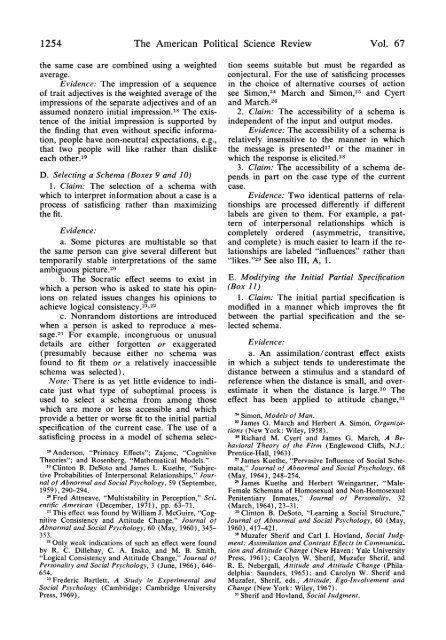Schema Theory: An Information Processing Model of Perception and ...
Schema Theory: An Information Processing Model of Perception and ...
Schema Theory: An Information Processing Model of Perception and ...
Create successful ePaper yourself
Turn your PDF publications into a flip-book with our unique Google optimized e-Paper software.
1254 The American Political Science Review Vol. 67<br />
the same case are combined using a weighted<br />
average.<br />
Evidence: The impression <strong>of</strong> a sequence<br />
<strong>of</strong> trait adjectives is the weighted average <strong>of</strong> the<br />
impressions <strong>of</strong> the separate adjectives <strong>and</strong> <strong>of</strong> an<br />
assumed nonzero initial impressions The exis-<br />
tence <strong>of</strong> the initial impression is supported by<br />
the finding that even without specific informa-<br />
tion, people have non-neutral expectations, e.g.,<br />
that two people will like rather than dislike<br />
each other.'9<br />
D. Selecting a <strong>Schema</strong> (Boxes 9 <strong>and</strong> 10)<br />
1. Claim: The selection <strong>of</strong> a schema with<br />
which to interpret information about a case is a<br />
process <strong>of</strong> satisficing rather than maximizing<br />
the fit.<br />
Evidence:<br />
a. Some pictures are multistable so that<br />
the same person can give several different but<br />
temporarily stable interpretations <strong>of</strong> the same<br />
ambiguous picture.20<br />
b. The Socratic effect seems to exist in<br />
which a person who is asked to state his opin-<br />
ions on related issues changes his opinions to<br />
achieve logical consistency.2"22<br />
c. Nonr<strong>and</strong>om distortions are introduced<br />
when a person is asked to reproduce a mes-<br />
sage." For example, incongruous or unusual<br />
details are either forgotten or exaggerated<br />
(presumably because either no schema was<br />
found to fit them or a relatively inaccessible<br />
schema was selected).<br />
Note: There is as yet little evidence to indi-<br />
cate just what type <strong>of</strong> suboptimal process is<br />
used to select a schema from among those<br />
which are more or less accessible <strong>and</strong> which<br />
provide a better or worse fit to the initial partial<br />
specification <strong>of</strong> the current case. The use <strong>of</strong> a<br />
satisficing process in a model <strong>of</strong> schema selec-<br />
18 <strong>An</strong>derson, "Primacy Effects"; Zajonc, "Cognitive<br />
Theories"; <strong>and</strong> Rosenberg, "Mathematical <strong>Model</strong>s."<br />
19 Clinton B. DeSoto <strong>and</strong> James L. Kuethe, "Subjec-<br />
tive Probabilities <strong>of</strong> Interpersonal Relationships," Jour-<br />
nal <strong>of</strong> Abnormal <strong>and</strong> Social Psychology, 59 (September,<br />
1959), 290-294.<br />
1 Fred Attneave, "Multistability in <strong>Perception</strong>," Sci-<br />
entific American (December, 1971), pp. 63-71.<br />
21 This effect was found by William J. McGuire, "Cog-<br />
nitive Consistency <strong>and</strong> Attitude Change," Journal <strong>of</strong><br />
Abnormal <strong>and</strong> Social Psychology, 60 (May, 1960), 345-<br />
353.<br />
22 Only weak indications <strong>of</strong> such an effect were found<br />
by R. C. Dillehay, C. A. Insko, <strong>and</strong> M. B. Smith,<br />
"Logical Consistency <strong>and</strong> Attitude Change," Journal <strong>of</strong><br />
Personality <strong>and</strong> Social Psychology, 3 (June, 1966), 646-<br />
654.<br />
23 Frederic Bartlett, A Study in Experimental <strong>and</strong><br />
Social Psychology (Cambridge: Cambridge University<br />
Press, 1969).<br />
tion seems suitable but must be regarded as<br />
conjectural. For the use <strong>of</strong> satisficing processes<br />
in the choice <strong>of</strong> alternative courses <strong>of</strong> action<br />
see Simon,24 March <strong>and</strong> Simon,25 <strong>and</strong> Cyert<br />
<strong>and</strong> March.26<br />
2. Claim: The accessibility <strong>of</strong> a schema is<br />
independent <strong>of</strong> the input <strong>and</strong> output modes.<br />
Evidence: The accessibility <strong>of</strong> a schema is<br />
relatively insensitive to the manner in which<br />
the message is presented27 or the manner in<br />
which the response is elicited.28<br />
3. Claim: The accessibility <strong>of</strong> a schema de-<br />
pends in part on the case type <strong>of</strong> the current<br />
case.<br />
Evidence: Two identical patterns <strong>of</strong> rela-<br />
tionships are processed differently if different<br />
labels are given to them. For example, a pat-<br />
tern <strong>of</strong> interpersonal relationships which is<br />
completely ordered (asymmetric, transitive,<br />
<strong>and</strong> complete) is much easier to learn if the re-<br />
lationships are labeled "influences" rather than<br />
"likes."29 See also III, A, 1.<br />
E. Modifying the Initial Partial Specification<br />
(Box 11)<br />
1. Claim: The initial partial specification is<br />
modified in a manner which improves the fit<br />
between the partial specification <strong>and</strong> the se-<br />
lected schema.<br />
Evidence:<br />
a. <strong>An</strong> assimilation/ contrast effect exists<br />
in which a subject tends to underestimate the<br />
distance between a stimulus <strong>and</strong> a st<strong>and</strong>ard <strong>of</strong><br />
reference when the distance is small, <strong>and</strong> over-<br />
estimate it when the distance is large.30 The<br />
effect has been applied to attitude change,31<br />
24 Simon, <strong>Model</strong>s <strong>of</strong> Man.<br />
'James G. March <strong>and</strong> Herbert A. Simon, Organiza-<br />
tions (New York: Wiley, 1958).<br />
25 Richard M. Cyert <strong>and</strong> James G. March, A Be-<br />
havioral <strong>Theory</strong> <strong>of</strong> the Firm (Englewood Cliffs, N.J.:<br />
Prentice-Hall, 1963).<br />
27 James Kuethe, "Pervasive Influence <strong>of</strong> Social Sche-<br />
mata," Journal <strong>of</strong> Abnormal <strong>and</strong> Social Psychology, 68<br />
(May, 1964), 248-254.<br />
James Kuethe <strong>and</strong> Herbert Weingartner, "Male-<br />
Female <strong>Schema</strong>ta <strong>of</strong> Homosexual <strong>and</strong> Non-Homosexual<br />
Penitentiary Inmates," Journal <strong>of</strong> Personality, 32<br />
(March, 1964), 23-31.<br />
29 Clinton B. DeSoto, "Learning a Social Structure,"<br />
Journal <strong>of</strong> Abnormal <strong>and</strong> Social Psychology, 60 (May,<br />
1960), 417-421.<br />
30 Muzafer Sherif <strong>and</strong> Carl I. Hovl<strong>and</strong>, Social Judg-<br />
ment: Assimilation <strong>and</strong> Contrast Eflects in Communica-<br />
tion <strong>and</strong> Attitude Change (New Haven: Yale University<br />
Press, 1961); Carolyn W. Sherif, Muzafer Sherif, <strong>and</strong><br />
R. E. Nebergall, Attitude <strong>and</strong> Attitude Change (Phila-<br />
delphia: Saunders, 1965); <strong>and</strong> Carolyn W. Sherif <strong>and</strong><br />
Muzafer, Sherif, eds., Attitude, Ego-Involvement <strong>and</strong><br />
Change (New York: Wiley, 1967).<br />
31 Sherif <strong>and</strong> Hovl<strong>and</strong>, Social Judgment.


